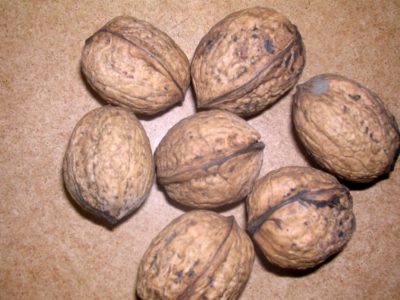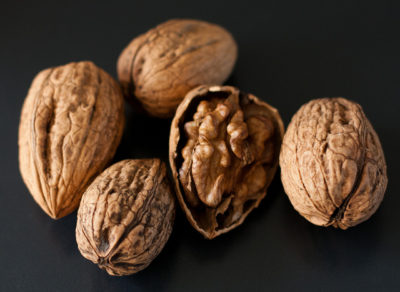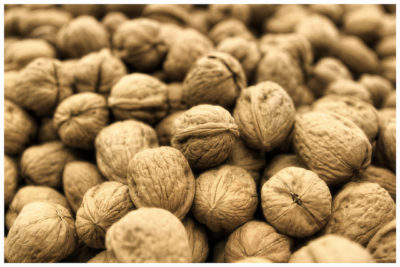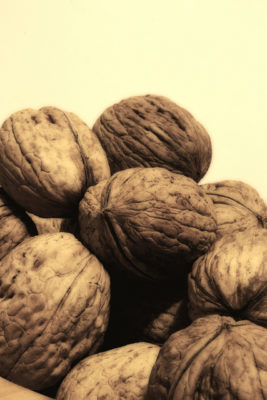
Walnuts
The Common walnut, Juglans regia, is a deciduous tree, native to Central Asia, specifically Iran and India. This tree has been cultivated for thousands of years, making it one of the oldest known tree foods. It is grown worldwide for its edible nuts and its wood.
The primary use of the Common walnut is for its nuts, which are eaten raw or cooked. The wood from the tree is highly valued for its hardness, fine grain, and dark color, used in making furniture and veneers. Additionally, parts of the plant have been used in traditional medicine, and the husks have served as a source for natural dyes.
Names
Scientific
Juglans regia
English
Common walnut
English walnut
Persian walnut
Walnut
Dutch
Gewone walnoot
Okkernoot
Perzische walnoot
Walnoot
Spanish
Nogal común
Nogal español
Nogal europeo
French
Noyer commun
Noyer royal
German
Baumnuss
Echte Walnuss
Persische Walnuss
Walnuss
Walnussbaum
Italian
Noce bianco
Noce da frutto
Taxonomy
Order
Fagales
Family
Juglandaceae
Genus
Juglans
Species
Juglans regia (Common walnut)
Basic information and facts
Origin:
Native to a wide region stretching from the Balkans eastward to the Himalayas and Southwest China.
Distribution:
Widely cultivated across temperate regions of the world, including Europe, Asia, and North America..
Annual, biennial, or perennial:
Perennial.
Flowers:
Male (staminate) flowers are yellowish-green catkins, hanging in clusters. Female (pistillate) flowers are small, greenish, and appear in short spikes at the tips of new growth. Both male and female flowers are borne on the same tree (monoecious).
Leaves:
Large, odd-pinnately compound leaves, typically 20-40 cm (8-16 inches) long, with 5 to 9 (sometimes up to 13) ovate leaflets. The leaves have a distinctive aromatic scent when crushed.
Fruits:
A round to oval drupe, 3-6 cm (1.2-2.4 inches) in diameter, encased in a green, fleshy husk that turns brown and splits open at maturity. Inside is the familiar hard-shelled nut, which contains the edible kernel.
Climate and weather:
Prefers temperate climates with distinct seasons. It needs a cold period for proper dormancy and nut production but is sensitive to late spring frosts which can damage new growth and flowers. Requires full sun and good air circulation.
Pollination:
Wind-pollinated. Walnut trees are monoecious, meaning they have separate male and female flowers on the same tree, but the timing of pollen release and female flower receptivity can vary, potentially requiring cross-pollination for optimal yields.
Height:
Can grow to a height of 20-35 meters (65-115 feet), with a broad, spreading crown.
Spacing:
For nut production, trees are typically spaced 9-15 meters (30-50 feet) apart to allow for their large mature size and ample sunlight.
Propagation:
Primarily propagated by grafting desirable cultivars onto rootstock, or by planting seeds (nuts) for establishing new rootstock or for genetic diversity.
Insect pests:
Susceptible to various pests including walnut husk fly, codling moth, walnut aphid, and ambrosia beetles.
Diseases:
Common diseases include bacterial blight, anthracnose, crown gall, and various cankers. Maintaining good air circulation and tree health can help prevent some issues.
Harvesting:
Nuts are harvested when the green husk dries, cracks, and the nuts fall to the ground, typically in late summer to early autumn. They are then collected, hulled (if husks haven’t fully separated), washed, and dried.
Uses:
Highly valued for its edible nuts, which are consumed fresh, roasted, or used in baking and confectionery. The timber is prized for its strength, durability, and beautiful grain, making it ideal for furniture, cabinetry, flooring, and gunstocks. Walnut leaves and husks also have traditional uses in dyes and medicinal preparations.
Crop categories
Cool temperate crops
Mediterranean crops
Nuts
Temperate crops
Wild-harvested crops
Pictures

Walnut - Photo by Pauline Mak

Walnut - Photo by Chris Gerrard

Walnut - Photo by FromSandToGlass

Walnut - Photo by lnvmsy

Walnut - Photo by Thomas
